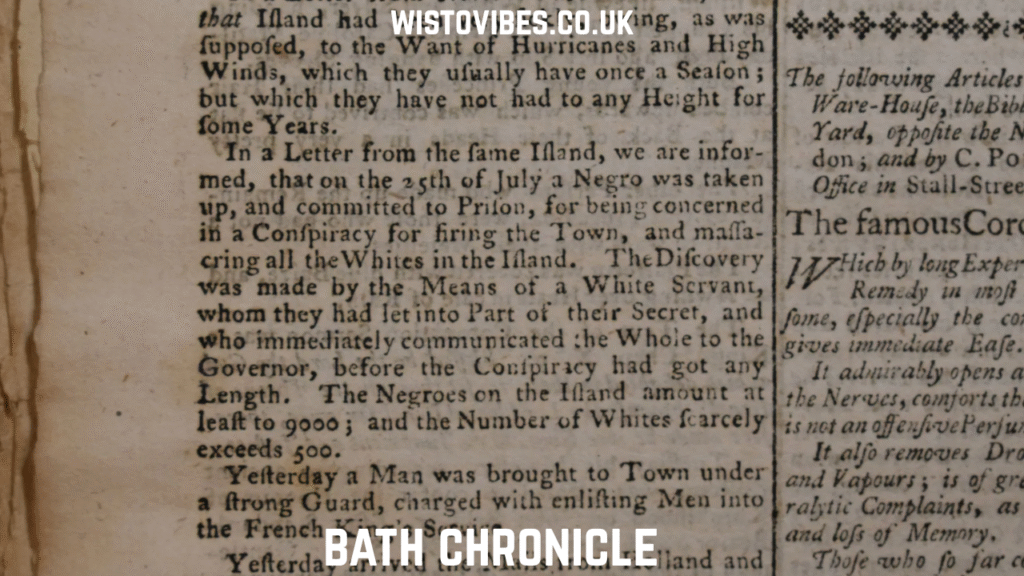The bath chronicle stands as one of the most iconic regional newspapers in the United Kingdom, tracing its roots back to the mid-eighteenth century. Established in 1760, it quickly grew to become a central voice for the people of Bath and the surrounding areas. During a time when local communities relied heavily on print media for information, the bath chronicle provided not only news coverage but also a record of cultural, social, and political events. Its early years coincided with Bath’s rise as a fashionable spa town, and the paper played a significant role in reporting on the visitors, developments, and debates that shaped the city’s reputation.
Bath Chronicle in the Georgian Era

In the Georgian era, Bath was known for its architecture, social gatherings, and literary connections. Figures like Jane Austen and other notable personalities spent time in the city, and the bath chronicle reflected this rich cultural backdrop. The newspaper captured the essence of Georgian society by documenting the lives of visitors and residents, social events, theater productions, and political discussions. As Bath flourished with its grand crescents and assembly rooms, the bath chronicle became an indispensable record of the city’s social pulse.
Role of Bath Chronicle in Local Politics
The bath chronicle also played a vital role in local politics. At a time when national newspapers were not widely accessible, regional publications like this one were crucial in shaping political opinions. Readers relied on the paper to keep up with parliamentary debates, council decisions, and issues that directly impacted their lives. The editorial stance of the bath chronicle often reflected the concerns and aspirations of Bath’s middle-class citizens, making it both a platform for civic engagement and a barometer of local sentiment.
Bath Chronicle and Social Life Reporting

One of the defining features of the bath chronicle was its coverage of social life. Bath was a hub for fashionable society, and its events—from lavish balls to literary gatherings—were meticulously documented in the paper. Readers eagerly anticipated details of who attended which event, what was worn, and which personalities were making waves. This focus on society reporting set the bath chronicle apart as not just a newspaper but a chronicle of lifestyle and culture, reflecting the aspirations of its readership.
Evolution of Bath Chronicle Through the 19th Century
During the 19th century, the bath chronicle adapted to major transformations in the world of journalism. Advances in printing technology allowed for wider circulation and more comprehensive coverage. The industrial revolution brought social challenges and political reforms, and the newspaper expanded its focus to include labor issues, education reforms, and urban development. Despite these changes, the bath chronicle remained rooted in its mission of serving the local community while adapting to the changing needs of its readers.
Bath Chronicle as a Community Voice

For centuries, the bath chronicle functioned as the primary voice of the Bath community. It reported on everyday life, from public health concerns to infrastructure developments and local festivals. The paper was more than a vehicle for news; it was a mirror reflecting the identity and values of Bath’s people. Families often preserved editions as keepsakes, and the newspaper’s archive became an invaluable historical resource for researchers and residents interested in tracing the city’s past.
Bath Chronicle in the 20th Century
The 20th century brought both challenges and opportunities for the bath chronicle. The two World Wars deeply affected the city, and the newspaper provided vital wartime updates, casualty reports, and morale-boosting stories. After the wars, the paper shifted its attention to reconstruction, cultural revitalization, and the evolving social fabric of Bath. The rise of television and radio posed new competition, but the bath chronicle maintained its relevance by offering in-depth local coverage unavailable in national media.
Cultural Contributions of Bath Chronicle
Beyond news, the bath chronicle made significant cultural contributions. By publishing reviews of theatrical performances, exhibitions, and concerts, it helped foster the city’s cultural scene. Bath’s theaters, museums, and festivals relied on the paper to attract audiences, and in turn, the readers benefited from its role as a cultural guide. The bath chronicle thus acted as both a supporter and promoter of Bath’s artistic community, enriching the city’s cultural life.
Bath Chronicle and Sports Coverage
Sports were another domain where the bath chronicle excelled. The paper reported extensively on local cricket, rugby, and football matches, highlighting both amateur and professional achievements. This sports coverage created a sense of unity among the community, giving local athletes recognition and encouraging sporting spirit. Bath’s famous rugby team, in particular, found enthusiastic coverage in the newspaper, strengthening the bond between the publication and its readers.
Bath Chronicle in the Digital Age
With the rise of the internet, the bath chronicle faced new challenges. Like many traditional newspapers, it had to adapt to the digital era by offering online editions and engaging with readers through digital platforms. Despite these transformations, the core mission of the bath chronicle—to provide meaningful and localized content—remained unchanged. The move to digital helped the paper reach wider audiences while preserving its heritage as a trusted source of news.
Influence of Bath Chronicle on Journalism
The bath chronicle has had a lasting influence on regional journalism. By focusing on the needs and interests of its community, it demonstrated the importance of local journalism in strengthening civic life. Many aspiring journalists found their training ground at the bath chronicle, learning the values of accuracy, community service, and accountability. Its editorial model has inspired similar publications across the United Kingdom.
Challenges Faced by Bath Chronicle
Like many print newspapers, the bath chronicle has faced significant challenges in recent decades. Declining circulation, competition from digital media, and changes in advertising have tested its resilience. Yet, despite these obstacles, the newspaper has managed to survive through adaptation and innovation. Its story reflects the broader struggles of regional journalism in the modern world, making it a case study in media evolution.
Bath Chronicle as a Historical Archive
One of the most valuable aspects of the bath chronicle is its role as a historical archive. Centuries of reporting have created a rich repository of information about Bath’s development, people, and culture. Scholars, genealogists, and historians frequently turn to the newspaper’s archives to uncover details about past events, social trends, and family histories. This archival function underscores the enduring significance of the bath chronicle beyond its immediate readership.
Bath Chronicle and Civic Identity
The bath chronicle has long been tied to the civic identity of Bath. By documenting milestones such as city planning projects, royal visits, and major celebrations, it reinforced the sense of pride among residents. The newspaper’s stories often emphasized the uniqueness of Bath’s heritage, architecture, and traditions, thereby strengthening the city’s identity on both a local and national stage.
Economic Impact of Bath Chronicle
The bath chronicle also had a direct economic impact on the city. Local businesses relied heavily on the paper for advertising, whether for job listings, products, or services. By connecting consumers with businesses, the newspaper contributed to the city’s economic vitality. The classified sections, in particular, were a staple of community commerce, making the bath chronicle an essential part of Bath’s economic ecosystem.
Bath Chronicle and Public Engagement
Another enduring legacy of the bath chronicle is its ability to foster public engagement. Letters to the editor provided citizens with a platform to voice opinions, debate issues, and hold authorities accountable. This engagement reinforced democratic values at the local level, ensuring that the concerns of ordinary residents were heard and considered. The bath chronicle was more than a publication; it was a forum for dialogue and civic participation.
Bath Chronicle in Modern Times
Today, the bath chronicle continues to serve as a vital source of news and information, albeit in a transformed media landscape. While print circulation has declined, the digital edition has expanded its reach, ensuring that the newspaper’s legacy continues into the twenty-first century. Its stories still capture the spirit of Bath, highlighting both the challenges and triumphs of its people.
Legacy of the Bath Chronicle
The legacy of the bath chronicle is deeply intertwined with the story of Bath itself. From its beginnings in the Georgian era to its present-day digital form, it has consistently provided a platform for news, culture, politics, and community engagement. Generations of readers have grown up with the paper, and its impact can be felt across multiple dimensions of the city’s life.
Bath Chronicle as a Symbol of Continuity
In an age of rapid change, the bath chronicle stands as a symbol of continuity. While many newspapers have disappeared, it has endured for more than two and a half centuries, adapting to new technologies and challenges. Its survival demonstrates the importance of local journalism and the resilience of community institutions that evolve with the times.
Conclusion and FAQs on Bath Chronicle
The bath chronicle is more than just a newspaper; it is a living history of Bath and its people. From chronicling the city’s fashionable past to reporting on its modern transformations, the newspaper remains an invaluable cultural asset. Its story is one of resilience, adaptation, and service to the community.
FAQs
Q1: When was the bath chronicle founded?
The bath chronicle was founded in 1760, making it one of the oldest regional newspapers in the United Kingdom.
Q2: What was the main role of the bath chronicle in Bath’s history?
The bath chronicle served as both a news source and a cultural record, documenting social life, politics, and community events.
Q3: Does the bath chronicle still exist today?
Yes, the bath chronicle continues to exist, primarily through its digital presence, though its print circulation has declined.
Q4: Why is the bath chronicle significant for historians?
The newspaper’s archives provide a detailed record of Bath’s history, offering valuable insights into cultural, social, and political developments.
Q5: What is the legacy of the bath chronicle?
Its legacy lies in its role as a trusted community voice, a cultural promoter, and a historical archive that reflects the identity of Bath.
Read More: Derbyshire Times Obituaries Remembering Lives and Honoring Legacies




